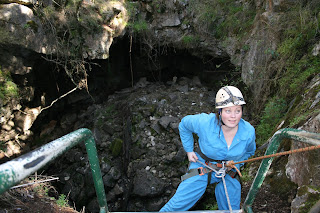A risky businessWhy I support risk-taking
 |
| Over the edge: abseiling into Jenolan Caves |
On a
recent rock-climbing trip in northern Sydney, I fell.
We’d had a tough morning
of climbing, and decided to do “just one more climb”. It was a relatively easy,
short climb on good rock, and I assumed I would just run up it, clip into the
bolts for protection, and then help haul the other, less-experienced climber to
the top.
Whether
it was the slippery start, a latent illness I was carrying, or just a bad climb,
I slipped and fell uncontrolled, plummeting towards the ground. Thankfully I
had clipped into a bolt a few metres below me, and as I fell, my belayer did
his part, and the bolt did the rest, arresting my fall a couple of metres off
the deck.
Rock-climbing,
like many of the activities I enjoy, involves responsible risk-taking: placing
yourself in a precarious position, but with the knowledge that you have taken ‘adequate
precautions’ (to use a euphemism).
 |
| Ken Eastwood caving, Jenolan Caves |
Whether mountain biking down a rocky slope,
scuba diving through the shark caves of Fish Rock, canyoning in the Blue
Mountains or taking a long overnight hike through rugged terrain, many of the
outdoor adventures I undertake have two elements of risk: known risks and
unknown risks. A wise and experienced lover of the outdoors becomes used to
weighing up these risks; factoring in weather and solutions to all the known
risks, and being prepared to encounter the unexpected.
It’s
these skills that I find so useful in other parts of life, whether planning to
direct a camp with more than 100 unpredictable teenagers, bringing up two kids,
a holiday with the family, or the rush and adrenaline of a deadline.
One of
the best Australian exponents of responsible risk-taking is highly successful
entrepreneur and adventurer Dick Smith, who I worked for briefly in the
Australian Geographic offices at Terrey Hills. A recent story in the International Business Times said, “his
story has always been about venturing into the exciting world of the unknown… [but]
Dick says he will never get into a business unless there's a good chance of
success in it. Even in his recreational adventurism, he says he would only
dabble if there’s a huge chance of him coming out of it successfully. It is
called responsible risk taking.”
Dick,
and the Australian Geographic Society, support the “spirit of adventure” which
led to young Australian mountaineers such as Christopher Harris becoming the
youngest person to climb the potentially lethal Mt Cook in New Zealand, at just
age 12. His dad, Richard,
told me, “I’ve certainly never worried about what other parents think – if you
worried about that you wouldn’t do anything.” With a focus on getting his kids
into scouts, Outward Bound, caving and rafting, Richard has encouraged and
motivated them to push boundaries into areas of high risk.
“When it comes to kids and wrapping them in cotton wool, I have a theory that we have more teenage suicides than ever before, and it’s because they aren’t having any near-death experiences, so they don’t learn to fear it,” he said.
Whether
or not we admit it, we all face huge, insidious risks every day. Statistically,
the most dangerous part of rock-climbing isn’t the abseiling or the actual
climbing. It’s the drive to the rock face.
Parents
have become obsessed with stranger danger, but statistically, strangers in
Australia offer miniscule danger to kids. If they are abused, it is almost
certainly going to be by someone they know and trust.
We
fear our kids playing in the bush by themselves, but I recently heard of a girl
who tripped on a long dress while playing “dress-ups inside” and broke her arm.
If
we don’t encourage kids to get out and have their own adventures, what about
the far more insidious risks of obesity, laziness, lack of imagination,
depression, inability to make their own wise decisions or going through life
thinking mediocrity is the goal?
 |
| Away from the marked trails, exploring Ku-ring-gai National Park |
Dr
Helen Little, lecturer at the Institute of Early Childhood at Macquarie University, began research
into risk-taking in children in 2005 with a PhD titled Children’s physical risk-taking in outdoor play: the influence of
individual, social and environmental factors. “Although the term 'risk-taking' often has negative
connotations, the reality is that the willingness to engage in some risky
activities provides opportunities to learn new skills, try new behaviours and
ultimately reach our potential. Challenge and risk, in particular during
outdoor play, allows children to test the limits of their physical,
intellectual and social development,” she wrote.
She’d
noticed an increasing trend of parents giving a blanket ‘no’ to their children
who want to take risks, such as climbing trees or walking around the outside of
the playground equipment, “without struggling to think ‘why am I saying no?
What is the issue and is it really an issue? There is no risk-benefit
assessment. Sure, as a parent you do [need to] look at the risks and the
hazards in the environment, but you weigh that up against the benefits – motor
development, spatial awareness, confidence – any aspect of their social
development.
“If
a child doesn’t do these things, step out of their comfort zone, they are going
to stagnate, they aren’t going to develop.”
 |
| Responsible parenting means taking risks |
It’s
the same with us, dear grown-ups. We all too easily retreat to the comfort of
our own mediocrity, unwilling to step through any doorway that might, possibly,
make us uncomfortable. And as a result, I fear, we will continually set ourselves
and those around us an agenda of stagnation.
Go
against the trend. Be bold. Take a risk this week. Do something you’ve never
done before. Weigh up the risks, and have a go. And let me know how it goes.
No comments:
Post a Comment